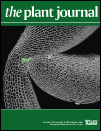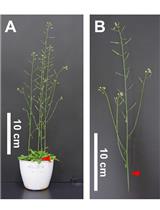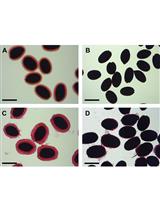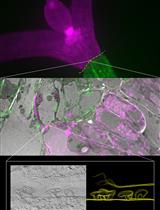- EN - English
- CN - 中文
Polyamine and Paraquat Transport Assays in Arabidopsis Seedling and Callus
拟南芥幼苗和愈伤组织中多胺和百草枯转运测定
发布: 2017年08月05日第7卷第15期 DOI: 10.21769/BioProtoc.2421 浏览次数: 7526
评审: Marisa RosaJoëlle SchlapferAnonymous reviewer(s)
Abstract
Polyamines (PAs) are polycationic compounds found in all living organisms and play crucial roles in growth and survival. We here show the ‘Polyamine and paraquat (PQ) transport assay’ protocol, which can be used to examine the uptake activity of PA/PQ transporters. We have used this protocol to demonstrate that PUT3 in Arabidopsis is a polyamine transporter and is able to take up spermidine and its analog paraquat.
Keywords: Arabidopsis thaliana (拟南芥)Background
PAs are involved in gene regulation by interacting with and modulating the functions of anionic macromolecules such as DNA, RNA and proteins. In living cells, PAs’ contents must be regulated to maintain the cellular hemostasis. In higher plants, three major polyamines, putrescine (Put), spermidine (Spd) and spermine (Spm), are present in either free form or conjugated forms with other molecules (Gill and Tuteja, 2010). In yeast, four plasma membrane polyamine transporters, DUR3, SAM3, GAP1 and AGP2 were identified (Uemura et al., 2007). In Arabidopsis, five putative polyamine uptake transporters (PUT1-PUT5) were identified and PUT1-3 have been experimentally validated as polyamine transporters (Mulangi et al., 2012; Li et al., 2013). Our protocol described below has successfully confirmed that PUT3 is an influx transporter for polyamines and paraquat, and PQ/Spd uptake is impaired in the put3 mutant (Shen et al., 2016).
Materials and Reagents
- Pipette tips
- Plastic Petri dish (VWR, catalog number: 25384-326 )
- Parafilm
- 1.5 ml Eppendorf centrifuge tube (VWR, catalog number: 20170-355 )
- Filter paper
- Blue pestle (DWK Life Sciences, Kimble, catalog number: 749521-1500 )
- Cuvette (VWR, catalog number: 414004-051 )
- Syringe filters, 0.2 µm pore size (VWR, catalog number: 28145-475 )
- Syringe
- Arabidopsis thaliana ecotype Columbia (Col-0) and mutant line lhr1 (put3)
- ScintiVerseTM BD Cocktail (Fisher Scientific, catalog number: SX18-4 )
- Clorox Bleach
- Triton X-100 (Sigma-Aldrich, catalog number: T8787 )
- (2,4-Dichlorophenoxy) acetic acid sodium salt monohydrate (Sigma-Aldrich, catalog number: D6679 )
- Kinetin (Duchefa Biochemie, catalog number: K0905 )
- Sodium hydroxide (NaOH)
- Murashige & Skoog Basal Salt Mixture (PhytoTechnology Laboratories, catalog number: M524 )
- Sucrose (Sigma-Aldrich, catalog number: S0389 )
- Agar (Sigma-Aldrich, catalog number: A1296 )
- Low melting point agarose (Sigma-Aldrich, catalog number: A9414 )
- Methyl viologen dichloride hydrate (Sigma-Aldrich, catalog number: 856177 )
- Spermidine (MP Biomedicals, catalog number: 02152068 )
- Paraquat-methyl-14C dichloride hydrate (Sigma-Aldrich, catalog number: 313947 )
Note: This product has been discontinued. - Spermidine trihydrochloride [Terminal Methylenes-3H (N)] (PerkinElmer, catalog number: NET522001MC )
- Trizma® base (Sigma-Aldrich, catalog number: T1503 )
- Ethylenediaminetetraacetic acid disodium salt dihydrate (EDTA) (Sigma-Aldrich, catalog number: E5134 )
- 2-Mercaptoethanol (Sigma-Aldrich, catalog number: M7522 )
Note: This product has been discontinued. - Seed sterilization solution (see Recipes)
- 2,000x 2,4-D (9.05 mM) (see Recipes)
- 2,000x kinetin (1.86 mM) (see Recipes)
- Callus induction solid medium (see Recipes)
- Callus induction liquid medium (see Recipes)
- ½ MS solid medium (see Recipes)
- ½ MS liquid medium (see Recipes)
- 200 µM non-14C-labeled PQ solution (see Recipes)
- 2.04 mM non-3H-labeled Spd solution (see Recipes)
- 40.37 µM non-3H-labeled Spd solution (see Recipes)
- Solution 1: 14C-labeled PQ solution (see Recipes)
- Solution 2: 14C-labeled PQ solution (see Recipes)
- Solution 3: 3H-labeled Spd solution (see Recipes)
- Solution 4: 3H-labeled Spd solution (see Recipes)
- Solution 5: 3H-labeled Spd solution (see Recipes)
- Solution 6: 3H-labeled Spd solution (see Recipes)
- 1 M Tris-HCl, pH 7.5 (see Recipes)
- 0.5 M EDTA, pH 8.0 (see Recipes)
- Crude protein extraction buffer (see Recipes)
Equipment
- Pipettes
- pH meter
- Weighing balance
- Laminar flow hood
- Stirring bar
- Magnetic stirrer (VWR, model: 200 Mini-stirrer )
- Vortex (Fisher Scientific, model: Vortex-Genie 2 )
- Scintillation counter (Beckman Coulter, model: LS-6500 )
- Centrifuge (Beckman Coulter, model: Microfuge® 22R , catalog number: 368831)
- Spectrophotometer (Bio-Rad Laboratories, model: SmartSpec Plus, catalog number: 1702525 )
Note: This product has been discontinued. - Autoclave
Procedure
文章信息
版权信息
© 2017 The Authors; exclusive licensee Bio-protocol LLC.
如何引用
Chai, H., Shen, Y. and Shi, H. (2017). Polyamine and Paraquat Transport Assays in Arabidopsis Seedling and Callus. Bio-protocol 7(15): e2421. DOI: 10.21769/BioProtoc.2421.
分类
植物科学 > 植物生理学 > 组织分析
您对这篇实验方法有问题吗?
在此处发布您的问题,我们将邀请本文作者来回答。同时,我们会将您的问题发布到Bio-protocol Exchange,以便寻求社区成员的帮助。
提问指南
+ 问题描述
写下详细的问题描述,包括所有有助于他人回答您问题的信息(例如实验过程、条件和相关图像等)。
Share
Bluesky
X
Copy link













